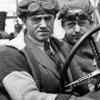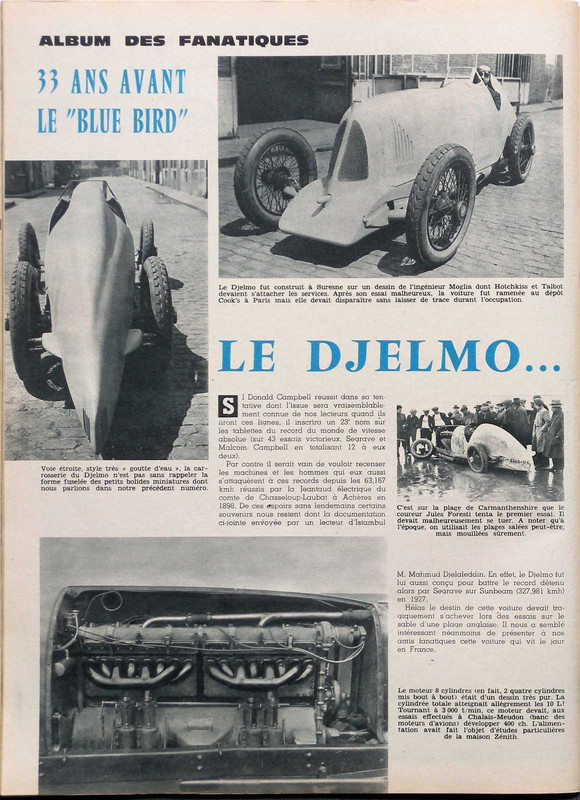From an old, meanwhile disappeared 2003 website,
an article written by Robin Richardson, with technical details based on the Autocar description of 1927:
By 1922-23 when the DJELMO was first conceived, the first World War had accelerated aviation engine technology to a point that lessons learned there were already being applied to land speed racers, Eldridge had built himself a huge FIAT based special using the lengthened chassis of the Mephistopheles Brooklands Car and inserting a FIAT A12 aero-engine. Malcolm Campbell, himself a Brooklands regular, had persuaded Sunbeam to sell him the Manitou V 12 aero-engined record holder which Guinness had used to set the record at 133mph in 1922. By 1924 when Campbell finally got his hands on it, he took the record to 146mph then 150mph on the Sands at Pendine. The only threat to this approach at the time was the much more sophisticated 10.5 litre V 12 Delage that was essentially a scaled up Grand Prix design. It set the record at 143mph in July; a record that was short lived once Eldridge and his FIAT arrived 6 day later having initially been disqualified for lack of a reverse gear - a situation soon remedied.
Presumably as a response to the Delage, Sunbeam drew up plans for a challenger of their own, one which did not rely on the use on an aero-engine. For whatever reason, Coatalen and Bertarione went no further with this design and sold it instead to Paris based Egyptian Prince Djellalledin and an Italian engineer Edmond Moglia - hence the car named DJELMO was born........Given the specification, it could have been a success had it been produced quickly. Indeed, the similar Delage was still winning races years later at Brooklands and is a regular today at events such as the Goodwood Festival of Speed.
Djelmo's chassis was a simple affair comprising two dep side members with a pronounced sweep up at the rear to clear the back axle. It was very crab-tracked being only 95cm at the rear compared to 1m 48cm at the front. Total weight was predicted to be 910kilos of which 350kilos was contributed by its straight eight cylinder engine. This was cast along with its gearbox as a complete unit that incorporated six evenly spaced bearers that bolted directly to the chassis to provide stiffness. The steering box was fitted to the top of the gearbox that housed 2 forward and one reverse gear driving through a bevel drive to a rear axle with no differential.
Brakes were on the rear only & featured a novel pedal and level arrangement guarranteed to confuse anyone used to today's layout. The clutch pedal was on the right, brake pedal on left which ONLY operated the left rear wheel brake!, the hand brake only operated the right rear wheel brake!!. A bore of 107mm and stroke of 140mm gave capacity of 10litres & power of 350hp, quite enough to make cope with by its braking system. No fuel pump was required, this was gravity fed from a tank under its scuttle. With its tightly cloaked body, later additions of superchargers planned were equally novel. (Contemporary reports indicate more than one) would have fitted in the tail, driven from the rear of the propshaft, compressed charge delivered by piping past the driver. The Prince predicted speeds circa 160mph at a site in USA (Prob. Daytona) initial tests were on roads at Arpajon in France where Eldridge & Rene Thomas battled using FIAT & Delage.
Like Moglia, Guilio Foresti was Italian living away from home in a capital city, London & was the earliest but only 'planned' driver for the project, Foresti was high profile already in road racing, London based had raced at Brooklands albeit not mentioned in Bill Boddy's track history. An agent for sales /service of Itala cars Foresti's Brooklands workshop plus larger premises at Bryanston Sq. Nr. Edgeware Rd. & had important engineering skills along with race ability.
A major affect upon LSR history followed by GF introducing one Leopoldo Alphonso Villa to the Challenges which were to follow, Villa was at a loose end after unexpectedly not following into his family catering, born in London of Italian parents his uncle Ferdy was an early car driver who ran a restaurant frequented by Foresti & knowing of Leo's mechanical eagerness he persuaded Foresti to take Leo on as a general helper, Leo grasped this chance & history took its course. Machinery being delivered as chassis to be assembled on site at Foresti's Bryanston Sq. premises was becoming highly favoured so much that when Count Louis Zborowski wanted a follow up to his aero-engined original Chitty Chitty Bang Bang he called Foresti to use an Itala chassis & 250hp Hall Scott aero-engine, unfortunately weak links proved to be Itala's g/box & drive chain & after 4 months work its road test saw the propshaft cry enough after a few yards shooting the car skywards as Foresti ran over a departing clutch and flywheel. Zborowski took the remains back to his Higham Estate & Foresti went back to conventional Itala work.
By 1917, Villa reached conscription age & Foresti as well as keeping business going took charge of transports for Italian Flying Corps in UK. to make use of experience whilst with Foresti Villa became posted to a unit fitting engines to planes, gaining further knowledge to be later invaluable when he worked with probably the most famous all time speed record breaker, M Campbell.
WW1 Armistice came, Villa went back to work for Foresti, this time as racing mechanic, one of their first projects was to rebuild a 16 yrs old Austro Daimler (essentially a 110hp Mercedes ) into a Brooklands racer. Even though often outclassed by more modern machinery Foresti remained competitive even winning the odd races here and there when conditions & lady luck supplemented their fine preparation work. Villa thrived on this experience meeting all the big names of the day - Malcolm Campbell, Zborowski, Kaye Don, Barnato etc whilst proving he was as competent a racing mechanic as Foresti was a Driver.....
By 1921, Foresti had also taken on Isotta Fraschini dealership although the deal suddenly turned sour for no obvious reason.....Undeterred he disappeared to Monte Carlo, returning a few weeks later to tell Villa that he'd bought a Car Hire company in the South of France & intended to move there as soon as possible to handle repair maintenance & continue their racing.....1921 Targa Floria was he first step & a modified Itala which Foresti & Villa prepared in Itala's Turin factory pre shipping it to Sicily....In spite of dreadful conditions & many mishaps they did well & won their 3 litre class. Reputations enhanced even further, Foresti sold the Car Hire business & took Villa to Ballot who were planning an assault on the following year's Targa with their more modern & smaller capacity cars....Team mate Jules Goux came second overall with Foresti & Villa fourth, & second in the 2 litre class.
BY 1922 an explosion whilst engine testing had put Villa in Hospital for a while, but Foresti continued to race with an old friend from his home town of Bergamo before moving back to England for a while. Brooklands rival Malcolm Campbell, impressed by the speed of the the Ballot cars (GF was already their UK dealer) wanted to race them at Brooklands & also wanted Foresti's experience along with it. As a 'sweetener' Campbell bought Foresti's old Itala racer. Clearly Villa had also made an impression on Campbell who wrote to the Ballot factory offering him a job in UK.
He had plenty of time to think about things whilst they took turns at driving the Itala and Ballot to Campbell's house at Povey Cross. Foresti stayed for 5 to 6 weeks, acting as Campbell's racing mechanic & no doubt sizing up facilities at Campbell's disposal. Decision time! & Foresti made it clear to Villa that it was an opportunity he should not pass up, but also revealing that he'd made plans of his own to race a still secret record breaker for Prince Djellaledin.
For whatever reasons, the Djelmo that would have been such a threat in early 20's when first mooted became less and less likely to succeed with every day of the year of delay. Thus it was 1927 before the car was brought to Pendine for an attempt on the British LSR, the World, absolute LSR, had already been raised to 203mph by Henry Seagrave in the 1000hp Sunbeam. after fixing a spate of engine problems Foresti made a number of high speed passes before a treacherous patch of soft sand brought the attempt to an end & Italy was denied a Land Speed Record holder, 'not far from the point Parry Thomas's tragic mishap seemed to start from & strangely these two events never seemed to have been studied to have perhaps been linked.....Djelmo went tumbling at an estimated 150mph & Foresti was lucky to emerge with nothing more than a scraped scalp & damaged arm,DJELMO was in an altogether worse state to be shipped back to Paris, never again to be seen running in anger, never to join those listed on the plaque at the Beach Hotel.
Drawn records only exist of the ideas for a planned replacement for DJELMO a sleeker lower car featuring twin engines fore & aft with the driver seated low in the middle. Remains of DJELMO were reported to be behind a Paris garage just prior to WW2 being carted away as scrap by Gypsies. Foresti continued racing on the continent, having missed his opportunity to be the only Italian ever to hold the land speed record. He had however become the mentor to Leo Villa, who would go on to serve the Campbell family in all their record breaking endeavours, right up until Donald's tragic death at Coniston with the K7 Bluebird jet-boat. Leo Villa inevitably came to be called 'Pancho' by British media!.
















